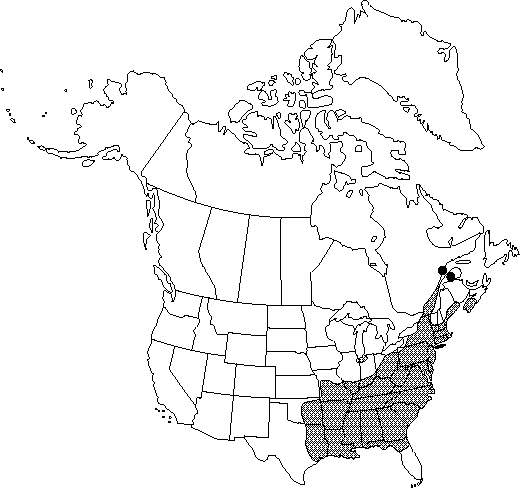Alnus serrulata
Sp. Pl. 4(1): 336. 1805.
Shrubs, open to rather densely ascending, to 10 m. Bark light gray, smooth; lenticels small, inconspicuous. Winter buds stipitate, ellipsoid to obovoid, 3–6 mm, apex mostly rounded; stalks 2–4 mm; scales 2, equal, valvate, moderately to heavily resin-coated. Leaf blade broadly elliptic to obovate, 5–14 × 3.5–8 cm, leathery, base broadly to narrowly cuneate, margins flat, serrulate, without noticeably larger secondary teeth, apex obtuse to rounded; surfaces abaxially glabrous to moderately villous, slightly to moderately resin-coated. Inflorescences formed season before flowering and exposed during winter; staminate catkins in 1 or more clusters of 2–5, 3–8.5 cm, stamens 4; pistillate catkins in 1 or more clusters of 3–5. Flowering before new growth in spring. Infructescences ovoid-ellipsoid, 1–2.2 × 0.6–1.2 cm; peduncles 1–3(–5) mm. Samaras obovate, wings narrower than body, irregularly elliptic or obovate, leathery. 2n = 28.
Phenology: Flowering early spring.
Habitat: Stream banks, ditches, edges of sloughs, swampy fields and bogs, and lakeshores
Elevation: 0–800 m
Distribution

N.S., Que., Ala., Ark., Conn., Del., D.C., Fla., Ga., Ill., Ind., Ky., La., Maine, Md., Mass., Miss., Mo., N.H., N.J., N.Y., N.C., Ohio, Okla., Pa., R.I., S.C., Tenn., Tex., Vt., Va., W.Va.
Discussion
Primarily an Atlantic coastal species, Alnus serrulata also grows along the St. Lawrence river system and the lower Great Lakes westward to the dunes of southern Lake Michigan, and across the southern states to the Gulf Coast and east Texas. Alnus serrulata was erroneously called A. rugosa in a number of earlier floristic works (J. K. Small 1903, 1933; N. L. Britton and A. Brown 1896, 1913; and B. L. Robinson and M. L. Fernald 1908), and the mistake was perpetuated in both editions of Flora Europaea (T. G. Tutin et al. 1964–1980, vol. 1; 1993+, vol. 1).
Alnus incana subsp. rugosa hybridizes with A. serrulata (= Alnus serrulata var. subelliptica Fernald). Extensive hybrid swarms occur where the ranges of these species overlap, including the area along the St. Lawrence River and the southern edge of the Great Lakes (F. L. Steele 1961). R. H. Woodworth's conclusion (1929, 1930) that apomixis occurs in A. serrulata resulted from his use of material selected from a hybrid swarm. The remainder of the species appears to reproduce normally. The two species and their hybrids are usually easily distinguished by leaf shape and margin characters.
Various preparations of Alnus serrulata were used medicinally by Native Americans to alleviate pain of childbirth, as a blood tonic, an emetic and purgative, for coughs and fevers, to stimulate kidneys, to bathe hives or piles, for eye troubles, indigestion, biliousness, jaundice, heart trouble, mouth soreness in babies, and toothaches, to lower blood pressure, and to clear milky urine (D. E. Moerman 1986).
Selected References
None.